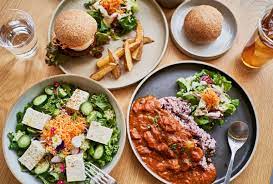The Art of Lunch: A Midday Culinary Delight
For many, lunch is more than just a meal; it’s a cherished midday ritual that provides a welcome break from the day’s activities. Whether you’re enjoying a quick bite at your desk or savoring a leisurely meal with friends, lunch offers a moment of respite and nourishment in the midst of a busy day.
One of the joys of lunch is its versatility. From hearty sandwiches and crisp salads to comforting soups and flavorful bowls, the options are endless. Lunch can be a time to indulge in your favorite dishes or to explore new flavors and ingredients.
Not only does lunch satisfy our physical hunger, but it also has the power to rejuvenate our spirits. A well-prepared meal can uplift our mood, boost our energy levels, and enhance our productivity for the rest of the day.
Sharing a meal with others during lunchtime fosters connections and strengthens relationships. Whether you’re catching up with colleagues over a business lunch or enjoying a family meal at home, the act of breaking bread together creates bonds that transcend mere sustenance.
At its core, lunch is an opportunity to pause, refuel, and appreciate the simple pleasures of good food. So whether you’re dining al fresco on a sunny patio or cozying up indoors on a rainy day, take a moment to savor the flavors and textures that make lunchtime truly special.
Common Questions About Lunch: Food Choices, Timing, and Terminology
- Which food is good for lunch?
- What is called lunch time?
- What is considered a lunch meal?
- Is it lunch or a lunch?
Which food is good for lunch?
When considering what food is good for lunch, it’s important to prioritize balance and nutrition. Opting for a meal that includes a mix of lean proteins, whole grains, healthy fats, and plenty of fruits and vegetables is key. A colorful salad with grilled chicken, quinoa with roasted vegetables, or a hearty vegetable stir-fry are excellent choices that provide a satisfying and nourishing midday meal. Incorporating a variety of food groups ensures you’re getting the essential nutrients your body needs to fuel you through the rest of the day. Remember to listen to your body’s cues and choose foods that leave you feeling energized and satisfied after your lunch break.
What is called lunch time?
“Lunchtime is the designated period in the middle of the day when individuals typically pause from their daily activities to consume a meal. It serves as a crucial break that nourishes both the body and mind, providing a moment of relaxation and sustenance during the busy hours. This midday interval varies across cultures and workplaces but universally represents a time to refuel, recharge, and enjoy a satisfying meal before continuing with the day’s tasks.”
What is considered a lunch meal?
A lunch meal typically consists of a balanced combination of food items that provide nourishment and sustenance during the midday hours. Common components of a lunch meal include a protein source such as lean meats, poultry, fish, tofu, or legumes, accompanied by carbohydrates like whole grains, vegetables, and fruits. Salads, sandwiches, soups, wraps, and grain bowls are popular lunch options that offer a mix of flavors and textures. The key is to create a satisfying meal that fuels the body and mind for the remainder of the day while also appealing to personal taste preferences and dietary needs.
Is it lunch or a lunch?
The question of whether to say “lunch” or “a lunch” often arises due to the singular nature of the meal. While both “lunch” and “a lunch” can be used in English, the choice depends on the context in which they are used. When referring to the concept of lunch in a general sense or as a routine mealtime occurrence, it is common to simply use “lunch.” On the other hand, when specifying a particular instance or type of lunch, using “a lunch” can help to clarify and emphasize the individuality of that specific meal. Ultimately, both forms are correct and serve different purposes in conveying meaning within everyday language usage.

